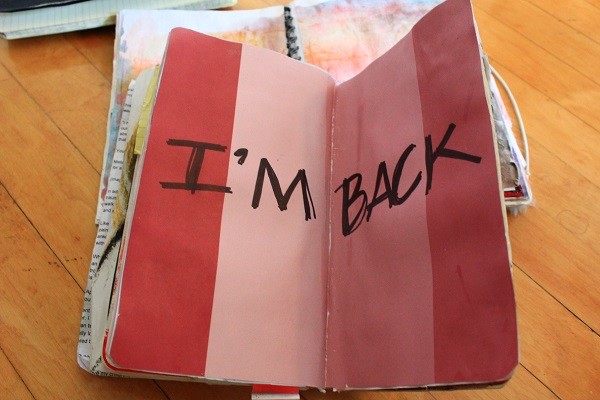Doodling to Distract – The “Art” of Visual Journaling
In my blog post last week, I discussed the benefits of creating art in an art therapy context. This week, I want to talk a little bit about the benefits of creating art on your own. I started keeping a visual journal in college. It was assigned to me by my favorite professor, and like any type-A, perfectionistic, overachieving, only child, I embraced the idea with gusto.
We were taught that visual journaling encouraged us to look closer, and more thoughtfully, at our artwork. Sometimes we were “prompted” to make art in our journal: I’d like you to create a visual representation of your family this evening. Please try not to use human figures. Take some time with your visual journal to help you to de-stress from final exams this week…
Sometimes we were left to our own devices.This process was painstaking for me, at first. I was new to art therapy and had absolutely no idea how to make art quickly, automatically, and casually. For most artists, their work is technical, intentional, and exact. There are rules. To be asked to complete an image in a few minutes is unrealistic. But this is how I approached my visual journal. I made each page technically sound, aesthetically balanced and beautiful.
I wasn’t engaging in “art therapy art.”
What is Art Therapy Art?
The term “art therapy art” comes up from time to time in the art therapist community. It’s somewhat derogatory, because it implies that art created in an art therapy context is different than “real” art. Different in a bad way. Less than. Other.
I disagree. I believe, passionately, that the art my clients and I create in session is rich. It has layer upon layer of meaning and intention, and that makes it just as valuable as any museum piece.
The purpose of art therapy art and keeping a visual journal is to encourage the artist to notice patterns, discover insight, and create some quiet serenity and order. The purpose is not to create a critically acclaimed and visually pleasing masterpiece..
The Art of Visual Journaling
This may shock you, but you don’t have to identify as an artist to make art. Think of working with your visual journal as “keeping notes.” Also remember that the content you put in your journal can incorporate any visual or written language. This could include: collage, song lyrics, scrapbooking, list-making, and scribbling.
Visual Journals Self-Soothe
Doodling is a wonderful way to distract an anxious mind. It gives you something to do with your hands, prevents you from saying nasty words out of frustration, and gives you a respite from toxic, ruminating thoughts. Keeping a visual journal in your purse or you bag is also an example of a “transitional object,” or a tool to help you feel more comfortable in uncomfortable situations.
Visual Journals Reveal Patterns
My art teacher said, “You’ll find patterns in your art.” I rolled my eyes. I figured I already knew about any patterns in my thinking, and wasn’t going to discover anything I didn’t already know. I was wrong. Patterns don’t have to be complex, simply noticing the heaviness with which you’re using your material, or the rate at which you’re producing new content, can be a telling and introspective opportunity…
Visual Journals Detect Changes
Similarly, you’ll notice life changes, stressors, and transitions reflected in your art. I save found grocery lists (I’ve got a thing for other people’s grocery lists), concert tickets, and brochures in my visual journal. As dumb as it sounds, when I flip through my visual journals I’m reminded, “Wow, I was busy this month. No wonder I’m exhausted.” Or, “I’m really grateful I’ve had so many new experiences this year. I’ve really branched out!”
So Basically I’m My Own Art Therapist?
No. And this is sort of complicated, so I apologize. “Art as therapy” is when an individual makes art independently, with goals like relaxation and personal expression. Just as you don’t need a therapist to ground or distract yourself, you don’t need an art therapist to practice “art as therapy.” Art therapy pioneer, Edith Kramer forwarded the concept that the act of art making is, in itself, therapeutic, the product benefitting the creator.
When an individual creates art alongside an art therapist, and works towards therapeutic goals, that is Art Therapy. An art therapist will prompt your creative process, move you out of your comfort zone, and help you to develop conclusions about both your art and your health. Taking visual notes in a journal is a bonus. I encourage you to help me take back the term “art therapy art” and do some introspective creating of your own.
This is what I created today. How did you express yourself?
All visual journal art created by author Jessica Kimmel
___________________________________________________________________
Would You Like to Take the Next Step and Get Help?
Toll Free. Confidential
616.202.3326






